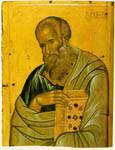|
|
| Portable Icons |
14th c., 3rd quarter Vatopedi Monastery Wood, egg tempera, 119 x 94 cm |
|

|
St John is depicted from the waist up, turning three-quarters to the right, his right hand holding a closed Gospel under his left arm. The icon is now smaller than its original size, which is estimated at 138 x 95 cm. The saint is portrayed with an exceptionally wide and bulky, sculpturesque body, and a short brawny neck supporting a large head with a very high forehead. At first sight, this burly, almost athletic, figure, with its bulky body and strong neck, seems to have connections with monumental paintings of the early Palaeologan period, notably the wall paintings in the Protaton (Millet 1927, pl. 23.2, 37.2, 39.1. Chatzidakis 1972 (1), figs. 1-2). However, a careful scrutiny of the icon shows that, both typologically and stylistically, it is very closely related to works - wall paintings and icons - of the third quarter of the fourteenth century, which manifest a tendency to return to early Palaeologan iconic models. Characteristic in this respect is the icon's typological and physiognomical resemblance to the wall painting of St John the Theologian (1360-70) in Pantokrator Monastery, Mount Athos (Tsigaridas 1978, pl. 7), and particularly to the icon of St John the Theologian from the Great Deesis in Chelandari Monastery (Vocotopoulos 1995, fig. 120), a work which is generally agreed to date to about 1360. The Vatopedi icon shares not only typological and physiognomical similarities with the Chelandari icon, but also the modelling of the face and the garment. The underpainting is a deep olive-green, the flesh wheaten with limited brighter spots producing a luminous sheen on the face, and with linear highlighting in a technique and style similar to that of the Chelandari icon. The drapery too, which is wide and supple with greyish-white highlighting on a golden-yellow ground, gives the impression of a garment naturally enveloping a robust body, in much the same way as the drapery in the Chelandari icon. The beard too, which, as in the Chelandari icon, is greyish-white, is rendered not summarily but with a softness very true to life. The hand is striking with its long, shapely fingers and clearly marked joints. Despite some minor differences, which chiefly relate to the emphasis on the physical bulk in the Vatopedi icon, the close artistic similarity between the two icons strongly suggests that they are products of the same workshop (Tsigaridas 1996 (2), pp. 356-64) and reflect an artistic trend of the third quarter of the fourteenth century characterised by a return to early Palaeologan iconic models. The sublime spirituality of the figures and the artistic links already pointed out (Tsigaridas 1966 (1), p. 386) between the Great Deesis icons in Vatopedi and the Evangelists in Cod. no. 16, which was a gift from John VI Cantacuzenos to the monastery, permit us to suggest that the Great Deesis icons both in Vatopedi and in Chelandari reflect the Hesychast spiritual movement and were produced by a Constantinople atelier which continued the techniques of the workshop that produced Vatopedi Cod. no. 16 in 1340-1 (Lamberz 1996, fig. 506. Kadas 1996 (1), fig. 544). It may well be that the Great Deesis icons, like Cod. no. 16, were given to the monastery by John Cantacuzenos.
| |
|
Bibliography: Tsigaridas 1996 (1), pp. 384-6, fig. 326. Tsigaridas 1996 (2), pp. 361-2, fig. 10.
| ||
| E.N.T. | ||
| Index of exhibits of Monastery of Vatopedi 14th century |
||
Reference address : https://www.elpenor.org/athos/en/e218ab24.asp